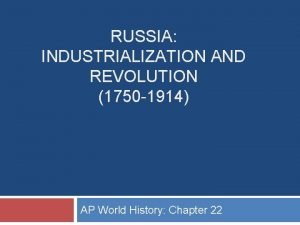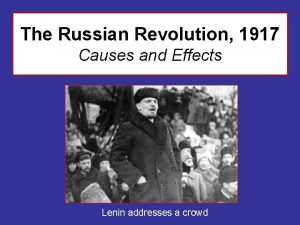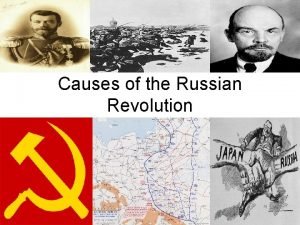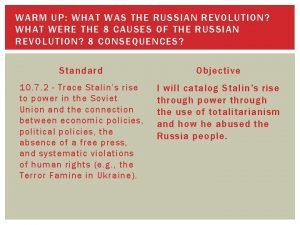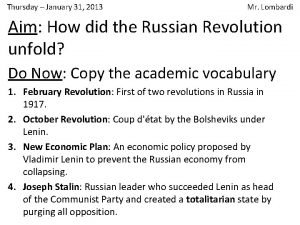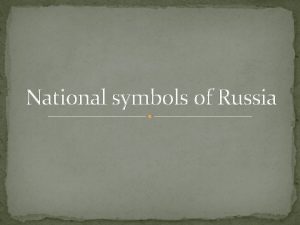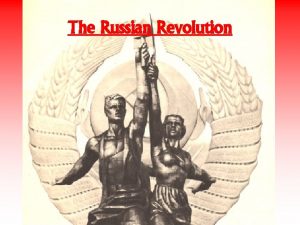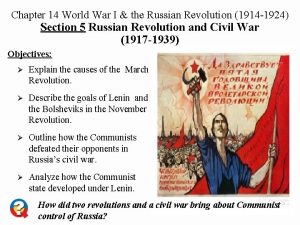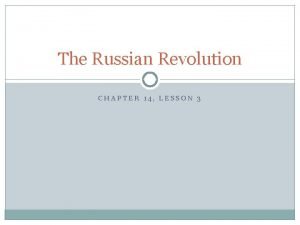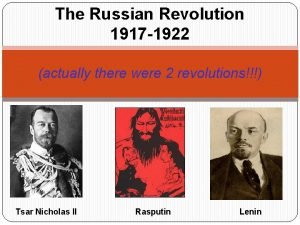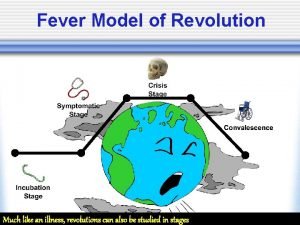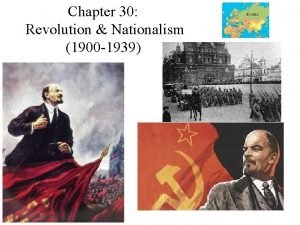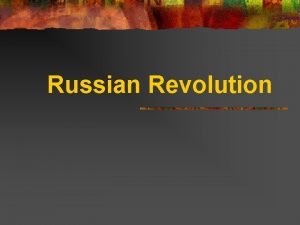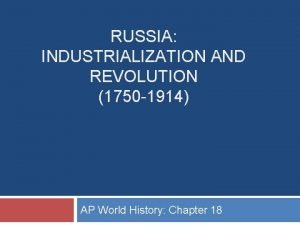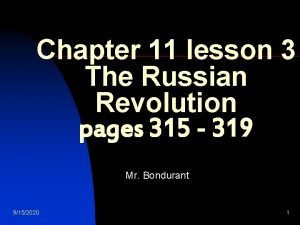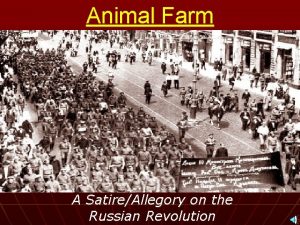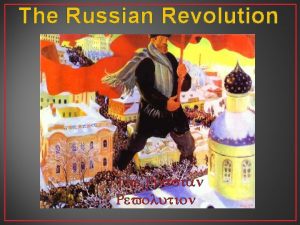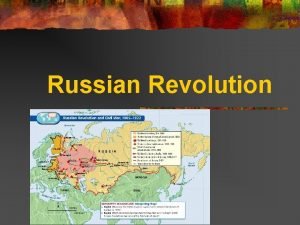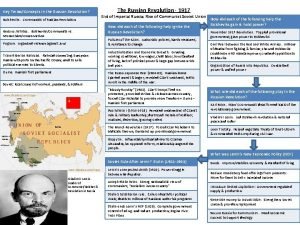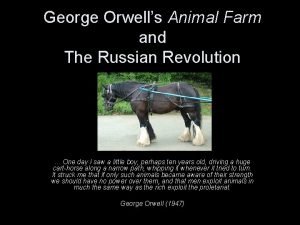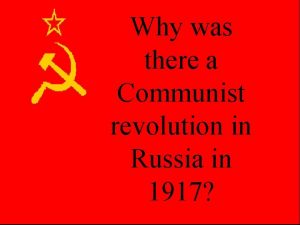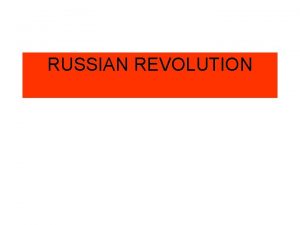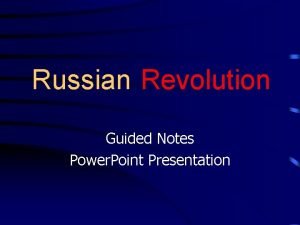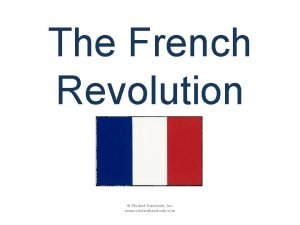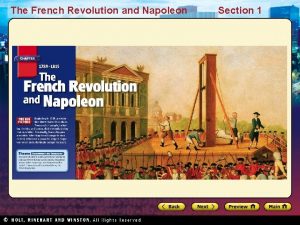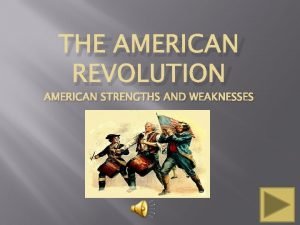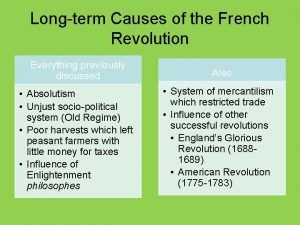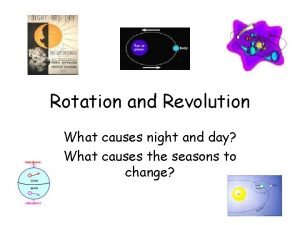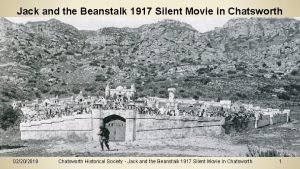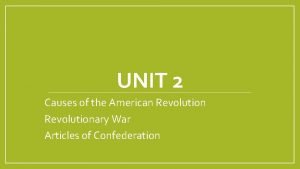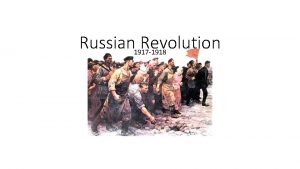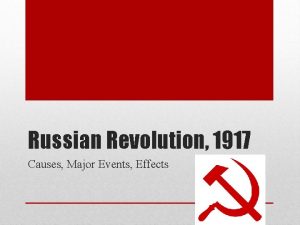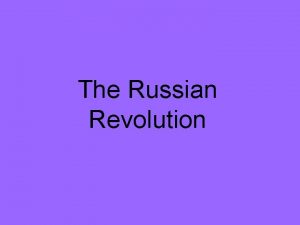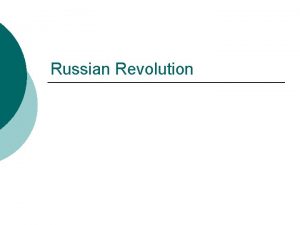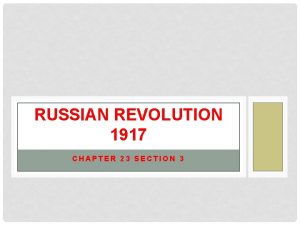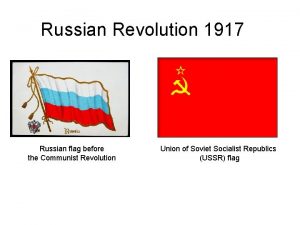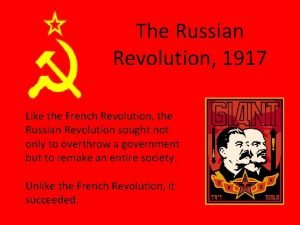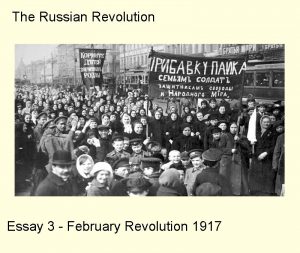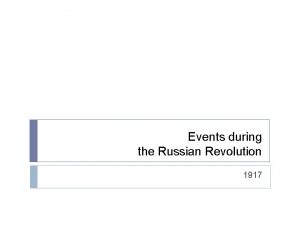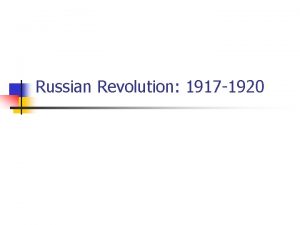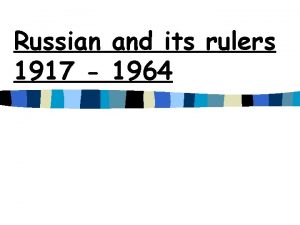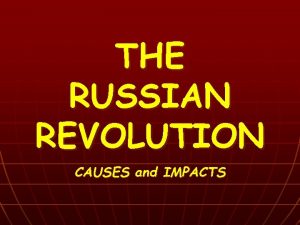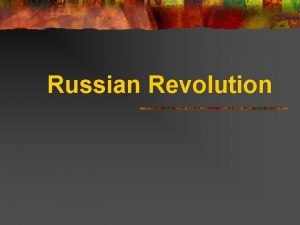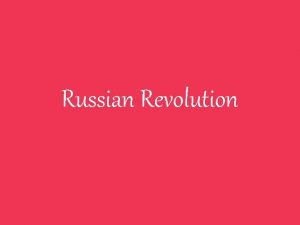CAUSES OF THE 1917 RUSSIAN REVOLUTION And the










































- Slides: 42

CAUSES OF THE 1917 RUSSIAN REVOLUTION And the Rise of Communism

Russian failures in the First World War The weakness of Tsar Nicholas II The discontent of the peasants The discontent of the workers The failure of the Duma Factors that led to the Communist revolution in 1917. Rasputin and scandal Opposition of the Communists The February Revolution 1917

Weakness of Tsar Nicholas II The ruler of Russia was Tsar Nicholas II. He was an absolute monarch, meaning that he had total power in Russia. Nicholas was a weak man. He used his secret police, the Okrana, to persecute opponents. Books and newspapers were censored. The Church supported the Tsar – the ‘Little Father of the Russian people’. Nicholas II ruled a vast country that was almost medieval in comparison to other countries. The Tsar’s undemocratic government was a major cause of the revolution.

Failure of the Duma In 1905 Russia lost a war with Japan. This defeat caused strikes in the Russian cities, the Tsar nearly lost control. Nicholas II offered to call a Duma, or parliament, with free elections. This was accepted by the demonstrators. When the Duma met, it began to criticise the Tsar and demanded changes. Nicholas II did not like this at all. The Duma was dismissed and new elections, controlled by the Tsar, were called. It became clear that the Duma would be shut down if it criticised the Tsar. As long as the Tsar had control of the army, his power could not be broken.

The discontent of the Workers Industrialisation began much later in Russia than in Western Europe. Huge iron foundries, textile factories and engineering firms were set up. Most were owned by the government or foreigners, and were located in the big cities such as St Petersburg or Moscow. By 1900 20% of Russians were workers living in cities. Working conditions in the new industrial towns were hard. Pay was very low. Although strikes and demonstrations were illegal, they often took place. Strikers were frequently shot by the Tsar’s soldiers or secret police. ‘The whole day we pour out our blood and sweat. Every minute we are exposed to danger. ’ Union leaflet 1898

The discontent of the Peasants Russia was a rural society with over 90% of the people being poor peasants. Until 1861 the peasants had belonged to their masters, who could buy and sell them like animals. When the peasants were freed in 1861 they were given small amounts of land for which they had to pay back the government. As a result most farmers were in absolute poverty. Agriculture was in desperate need of modernisation. In contrast, a small number of upper-class people held most of the wealth and power. This aristocracy had large town houses and country estates. Very often the peasants do not have enough allotment land. They cannot feed themselves, clothe themselves, heat their homes, keep their tools and livestock, secure seed for sowing and lastly pay their taxes. Police report into country conditions 1905

RUSSIA AND WORLD WAR I • Russian was not prepared for WW 1. Nine years previously Russia lost a war with Japan and the 1905 Revolution revolt and uprising had shaken the Russian Empire. Physically and economically the country was still trying to recover. However, national pride was strong and when the call to war was sounded, many troops rallied to flight under the Russian flag. • Tsar Nicholas II had hoped that victory in the great war would help their nation become great again, but a lack of readiness and supplies meant that Russia suffered huge losses in their first two battles. • Russia did very little to stop the German advancement in 1915, but 1916 saw some improvements. They got more arms and supplies which helped strengthen their armies. They managed to get some victories. • The country's political and economic problems were greatly exacerbated by the war. Many factors - including the militarisation of industry and crises in food supply - threatened disaster on the home front. • Added to all of this were rumours that the tsarina, Alexandra, and her favourite, the infamous Rasputin, were German spies. The rumours were unfounded, but by November 1916 influential critics of the regime were asking whether Russia's misfortunes - including 1, 700, 000 military dead and 5, 000 wounded - were a consequence of 'stupidity or treason'. • On October 26, 1917, the Soviet government issued a decree of peace, insisting that all belligerent powers open immediate negotiations for a democratic peace without annexations, and guarantee the right of every nation to self-determination (Russia was the only nation to do so at the end of the war, allowing all the former territories of Russia to self-determination. Independence was short lived however, as each republic was later incorporated/annexed into the Soviet Union by Stalin. ). The Entente refused to recognise the Soviet government, and continued the war. The Soviet government signed the Treaty of Brest-Litovsk on March 3, 1918, ending four years of aggression between Russia and Germany.

• Tsar Nicolas attempted to be patriotic and command the Russian troops, but he was a very poor leader. He ignored the needs of his commanders • That, in hand with the Russian people not trusting his wife (she was German), Russia became very unstable.

Rasputin • Grigori Yefimovich Rasputin was born into an extremely poor Russian family. After failing to become a monk, he became an experience traveller, mystical healer and a trusted advisor to the Tsar and his wife. While his influence has been questioned, he was very much relied upon by the family. • As Russia entered World War I, Rasputin predicted that calamity would befall the country. Nicholas II took command of the Russian Army in 1915, and Alexandra took responsibility for domestic policy. • Always Rasputin's defender, she dismissed ministers who were said to be suspicious of the "mad monk. " Government officials tried to warn her of Rasputin's undue influence, but she continued to defend him, giving the impression that Rasputin was her closest advisor. She apparently turned to him for advice on spiritual and political issues. • Between 1906 and 1914, various politicians and journalists used Rasputin’s association with the imperial family to undermine the dynasty’s credibility and push for reform. Rasputin helped their efforts by claiming to be the Czarina’s advisor, and accounts of his rampant lascivious behaviour emerged in the press, compounding contempt among state officials. In truth, however, Rasputin's influence at this time was limited to the health of Alexis (Son who had hemophilia).

• On the night of December 29, 1916, a group of conspirators, including the czar's first cousin, Grand Duke Dmitri Pavlovich, and Prince Felix Yusupov, invited Rasputin to Yusupov's palace and fed him wine and cakes laced with cyanide. Though Rasputin eventually became rather drunk, the poison seemed to have no effect. Baffled but not deterred, the conspirators finally shot Rasputin multiple times. He was then wrapped in a carpet and thrown into the Neva River, where it was discovered three days later. • Although Rasputin was gone, the last of his prophecies was yet to unfold. Shortly before his death, he wrote to Nicholas to predict that if he were killed by government officials, the entire imperial family would be killed by the Russian people. His prophecy came true 15 months later, when the czar, his wife and all of their children were murdered by assassins amidst the Russian Revolution.

The opposition of the Communists Many middle-class Liberals and Social Revolutionaries (who supported the peasants) opposed the rule of the Tsar, but the most revolutionary were the Social Democrats or Communists. The Communists believed in the ideas of Karl Marx claimed that history is all about the struggles between the classes. He claimed that the capitalist system was unfair because the factory owners (bourgeois) made profits from the toils of the workers (proletariat). Marx predicted that the proletariat would violently overthrow the bosses and take control of the country on behalf of the people. The Russian Communists were divided into the Bolsheviks led by Lenin and the Mensheviks led by Trotsky. Lenin believed that the small party of Bolsheviks should seize power and control Russia on behalf of the people. Before 1917 Lenin and many of the other Communist leaders were in exile abroad, plotting to bring about a revolution in Russia

RISE OF THE BOLSHEVIKS • The Bolsheviks were a political party born out of a split in the Social Democrat Party in 1903. They had one, influential leader – Vladimir Lenin. • Lenin believed that the people had to revolt to take the power away from the nobility. He wanted to give rise to a “dictatorship of the proletariat” (working class people). • Lenin and the Bolsheviks promised the people “Peace, Land Bread” • After the Tsar family were removed from power, a temporary government was put in place. However, Lenin and his party soon removed them by uniting the people against the government.

BOLSHEVIKS STEPS TO POWER February Revolution In March 1917 -- February in Russia, which used the Julian calendar -- a popular uprising in Petrograd supported by factory workers forced Czar Nicholas II to step down (abdicated), marking the end of the country's history of monarchical rule. The whole family were soon imprisoned, and in July 1918 they were all executed. In the wake of the revolt, a provisional government consisting of members of the Duma, or state legislature, vied for power with a more radical labor union of workers and soldiers known as the Petrograd Soviets. Both entities worked together, however, and agreed that a somewhat democratic system should replace the monarchy.

October Revolution The February Revolution prompted Lenin's return to Russia in April. He immediately condemned the collaboration between the provisional government and the Petrograd Soviet and began organizing Bolshevik opposition accordingly. After a few failed attempts at inciting an overthrow, in November, in what is known as the October Revolution, the Bolsheviks seized the Winter Palace and other government buildings in Petrograd. With little resistance from the provisional government, Lenin was henceforth the head of a Marxist country, the first of its kind.

Russian Civil War While few lives were lost in the October Revolution in which the Bolsheviks came to power, the opposite is true of the civil war that followed. In March 1918, Lenin's government signed the Treaty of Brest-Litovsk, which ended Russia's military involvement in World War I, but in the process made enormous territorial concessions to Germany and its fellow Central Powers. The treaty further incensed Lenin's opponents and by summer, Russia had descended into a civil war between the Bolsheviks, or the Reds, and a coalition of anti-Bolshevik interest groups collectively known as the Whites. An unsuccessful assassination attempt on Lenin in August triggered the Red Terror, the ruthlessly violent suppression of anyone who opposed the Bolsheviks. The Bolsheviks emerged victorious in 1921, allowing Lenin to consolidate his dictatorship.

HOW DID LENIN IMPOSE COMMUNIST CONTROL IN RUSSIA BETWEEN 19171924?

The abandonment of the Constituent Assembly The Treaty of Brest-Litovsk 1918 The Civil War 19181921 The execution of Tsar Nicholas II 1918 Factors that helped Lenin impose Communist control in Russia 1917 -1924. War Communism The Cheka Success of the New Economic Policy The Kronstadt Revolt 1921

The abandonment of the Constituent Assembly 1917 Straight after the October Revolution of 1917, Lenin promised to hold elections for a Parliament to be known as the Constituent Assembly. Lenin renamed the Bolshevik Party as the Communist Party in order to win wider support. However, the Communists only won 175 seats out of 700, not enough for a majority. Therefore Lenin shut down the Constituent Assembly after only one day! Lenin was not prepared to share power with anyone. This was the first step in setting up a Communist dictatorship.

The Cheka (or secret police) In December 1917 Lenin set up a secret police force known as the Cheka agents spied on the Russian people in factories and villages. Anyone suspected of being anti-Communist could be arrested, tortured and executed without a trial. When opponents tried to assassinate Lenin in 1918, he launched the Red Terror campaign against his enemies. It is said that 50, 000 people were arrested and executed in this period.

The Treaty of Brest-Litovsk 1918 To successfully impose Communist control in Russia, Lenin realised that he would have to bring Russia out of the First World War. He feared that the war might bring about an end to Communist rule. By this time the Russian army was weakened by poor morale, desertions and a break down in discipline. It was incapable of resisting the Germans. In March 1918 Russia signed a humiliating peace treaty with Germany. Russia lost a huge amount of land in the West. This included about one-sixth of the population (60 million people), three-quarters of its iron and coal and over a quarter of the best farmland in Russia. The Treaty of Brest-Litovsk came at a high price for Russia, but Lenin knew he could not defeat Germany and his opponents in Russia at the same time.

The Treaty of Brest-Litovsk 1918 Russia Estonia Germany . Brest-Litovsk Latvia Lithuania Ukraine Russian territory ceded to Germany

The Civil War 1918 -1921 The opponents of the ‘Reds’, Lenin and the Communists, were known as the ‘Whites’. The Whites were a mixture of aristocrats, royalists, churchmen, army officers and many others. The Whites were led by Admiral Kolchak and Generals Deniken and Wrangel. The Whites were supported by Britain, France, Japan and the USA, countries that were alarmed at the possible spread of communism. At the same time, Lenin fought a war against Poland, a new country formed by the Treaty of Versailles in 1919. Although in a very dangerous position, the Communists were able to win the Civil War. This was because the Whites were divided, while the Reds controlled the key cities, industrial centres and communication links. Trotsky’s tough leadership of the new Red Army proved decisive in the victory over the Whites.


Leon Trotsky – founder and commander of the Red Army Every scoundrel who incites anyone to Every scoundrel who incites retreat or to desert will anyone to retreat or to desert will be shot! Every soldier who throws away Every soldier his rifle will be shot! who throws away his rifle will be shot!

The execution of Tsar Nicholas II July 1918 After his abdication in March 1917, Tsar Nicholas II and his family were arrested and sent to Siberia. In July 1918, the Romanovs were in Ekaterinburg, with a White army closing in on the town. Local communists were worried that the Tsar might be a rallying point for the Whites. As a result, Tsar Nicholas, his wife, their five children and four attendants were shot and bayoneted.

War Communism To win the Civil War and impose Communism in Russia, Lenin needed a strong Red Army supplied with weapons and food. The state took control of the factories and appointed managers to run them. Work was hard and long, food was rationed to only those who worked and trade unions were banned. To get enough food, the Cheka seized all surplus grain from the peasants. The peasants hid food or preferred to grow less rather than give it away free to feed the towns. Drought and famine hit Russia in 1921 – over 4 million people died. Food?

The Kronstadt Revolt 1921 War Communism made Lenin’s government very unpopular. Discontent amongst the peasants led to violence in the cities. Workers went on strike, in spite of the death penalty for striking. The most serious opposition to Lenin’s government came in March 1921. Sailors at the Kronstadt naval base near Petrograd revolted. They accused Lenin of breaking his promise to help the workers. Lenin ordered the Red Army to put down the revolt. This caused 20, 000 casualties and the leaders of the revolt were executed. However, the mutiny was a warning to Lenin that he might have to relax War Communism.

Success of the New Economic Policy 1921 To regain popular support, Lenin relaxed War Communism with the New Economic Policy (NEP). Smaller industries were returned to private ownership and peasants could sell their surplus on the open market. This was a return to capitalism and competition. Lenin hoped that NEP would give Russia ‘a breathing space’ to get back on its feet. Most of the Communist Party saw the need for NEP, but some were against it. On the whole NEP was a success. But it did create some problems. Some peasants, the Kulaks, became rich, while ‘Nepmen’ or businessmen made a profit in the towns. Some saw NEP as a betrayal of communism and return to the old system.

Communist control of the USSR by 1924 • Leningrad • Moscow

When Lenin died in 1924, he had been very successful in imposing a communist dictatorship in Russia. He had defeated all of his opponents and established a strong communist government. As each of the areas formerly belonging to the Tsar came under communist control, they were turned into socialist republics. In 1923 these became the Union of Soviet Socialist Republics (USSR). But, Lenin failed to provide a clear successor on his death. This led to four years of bitter struggle.

Who would succeed Lenin? OR Trotsky – Red Army Commander and Commisar of Foreign Affairs Stalin – Commisar for Nationalities

How did Stalin rule the USSR between 1928 -1941?

The Struggle for power: Stalin v Trotsky After the death of Lenin in 1924, there was a four year power struggle between Josef Stalin and Leon Trotsky over the succession to the Russian leadership. Trotsky believed that under his leadership Russia would become a catalyst for the spread of communism across the world. He had been very successful as commander of the Red Army in the civil war and appeared to have Lenin’s support. Stalin had not played a significant part in the revolution of 1917, but since then he had gathered control of a number of key posts in the Communist Party. Stalin was determined to win control of Russia for himself. He was not interested in international communism, he wanted to make Russia strong and with himself at its head. By 1928 Stalin emerged as the successor to Lenin and Trotsky was forced into exile.

Reasons for Stalin’s success When Lenin died he had warned the Communist Party of Stalin’s threat in his ‘Political Testament’. Comrade Stalin is too rude. Comrade Stalin, having become General Secretary, re has great power in his hands, and I am not sure that he always knows how to use that power with sufficient caution.

Reasons for Stalin’s success Although Lenin had not supported him, Stalin was in a strong position. As General Secretary of the Communist Party Stalin had responsibility for appointing posts in the Party. This meant he could remove opponents and replace them with his supporters. He was also popular in the Party as he wanted to concentrate on turning Russia into a modern, powerful state; this approach was called ‘Socialism in one country’. In contrast Trotsky was much less popular. He had been a Menshevik and had only joined the Bolsheviks in 1917. Trotsky was dismissed as Commissar for War in 1925 and from the Central Committee in in 1926. In 1927 he was expelled from the Communist Party and forced into exile in 1929. Stalin had Trotsky assassinated in Mexico in 1940. Other leading figures of 1917, Kamenev, Zinoviev and Bukharin, were also removed by Stalin.

Stalin’s dictatorship: purges and propaganda Even with his opponents removed, Stalin still felt insecure. He conducted a policy of purges between 1934 -1938. Millions were arrested, executed or sent to labour camps. Stalin used the NKVD, the secret police, to undertake the ‘Great Terror’. Stalin purged: • 90% of the army’s top officers, • every admiral in the navy, • 1 million Communist Party members, • some 20 million ordinary Russians. At the same time Stalin encouraged a cult of personality. Propaganda was used to make people aware of the part Stalin was playing in every aspect of life – work, home and leisure.

Stalin in 1928 REASONS FOR COLLECTIVISATION AGRICULTURE IS DEVELOPING SLOWLY, COMRADES. THIS IS BECAUSE WE HAVE ABOUT 25 MILLION INDIVIDUALLY OWNED FARMS. THEY ARE THE MOST PRIMITIVE AND UNDEVELOPED FORM OF ECONOMY. WE MUST DO OUR UTMOST TO DEVELOP LARGE FARMS AND TO CONVERT THEM INTO GRAIN FACTORIES FOR THE COUNTRY ORGANISED ON A MODEM SCIENTIFIC BASIS.

Collectivisation In the late 1920 s, Russia suffered a food crisis. To feed starving workers, Stalin ordered the seizure of grain from the farmers. But, just as happened under War Communism, the peasants hid food or produced less. In 1929 Stalin announced the collectivisation of farms. The most common was the Kolkhoz in which land was joined together and the former owners worked together and shared everything. Stalin persuaded peasants to join by attacking the Kulaks, peasants that had grown as a result of the NEP. Collectivisation had limited success and a terrible human cost, between 10 to 15 million people died as a result. Between 1931 and 1932, there was a famine in Russia as not enough food was being produced. By 1939, Russia was producing the same amount of food as it had in 1928. Collectivisation was clearly a disaster and the problem was even worse as its population had increased by 20 million - all of whom needed feeding.

We are 50 -100 years behind the advanced countries. We must make up this gap in ten years. Either we do it or they crush us. Stalin 1931 The Five Year Plans Stalin believed that industry could only develop through state control. Under GOSPLAN, three Five Year Plans set targets between 1928 -1941 to increase production. Russian industry changed enormously. New towns such as Magnitogorsk grew up and large projects such as the Dnieper hydroelectric dam were developed. The USSR became a major industrial country. The human cost was high. Forced labour killed millions, working conditions were poor and hours of work were long.


The effects of Stalin’s rule on men and women Millions of people suffered in Stalin’s purges – workers, peasants and members of the Communist Party itself. There was brutality, persecution, executions and forced labour. Millions died of starvation and over-work. The shops were empty ; clothes were dull and badly made and household items difficult to find. Although the USSR was a Communist state, the dictatorship of Stalin was just as complete, and in some ways even more bloody, than that of Hitler. But despite these appalling tragedies, there were some positive aspects to Stalin’s rule. For example schools were built and social insurance schemes were introduced. Russia became a modern industrial country.

The Great Patriotic War 1941 -1945 When Germany attacked the USSR in 1941, Stalin used the same ruthlessness to defend his country. The defence of the USSR was the bloodiest war in history and cost the lives of millions of people and the destruction of thousands of villages, towns and cities. The final victory in 1945 was, like everything else, put down to the personal leadership of Stalin by the Soviet propaganda machine. After the war, Stalin built up the USSR as a superpower, in opposition to the USA. This conflict was known as the Cold War. Stalin died in 1953.
 Industrialization definition ap world history
Industrialization definition ap world history Triple alliance ap euro
Triple alliance ap euro Causes and effects of the russian revolution
Causes and effects of the russian revolution Effect of russian revolution
Effect of russian revolution Russian revolution causes and effects
Russian revolution causes and effects Causes of the russian revolution
Causes of the russian revolution Russian revolution vs french revolution
Russian revolution vs french revolution Russian national symbols
Russian national symbols March 1917 revolution
March 1917 revolution Chapter 27 world war 1 and the russian revolution
Chapter 27 world war 1 and the russian revolution Kzbho6asboc -site:youtube.com
Kzbho6asboc -site:youtube.com Russian revolution cartoons
Russian revolution cartoons Lesson 3 the russian revolution
Lesson 3 the russian revolution Czar in russian revolution
Czar in russian revolution Russia after ww1
Russia after ww1 Russian revolution fever model
Russian revolution fever model Russian revolution vocabulary
Russian revolution vocabulary Http://www.history.com/topics/russian-revolution
Http://www.history.com/topics/russian-revolution Russian revolution of 1905 definition ap world history
Russian revolution of 1905 definition ap world history The russian revolution
The russian revolution Animal farm summary
Animal farm summary The russian revolution
The russian revolution The russian revolution
The russian revolution Russian revolution
Russian revolution Animal farm
Animal farm Introduction of russian revolution
Introduction of russian revolution Russian revolution
Russian revolution Russian revolution guided notes
Russian revolution guided notes French revolution causes and effects
French revolution causes and effects Causes and effects of the french revolution
Causes and effects of the french revolution French revolution
French revolution Strengths of the continental army
Strengths of the continental army French revolution causes and effects
French revolution causes and effects French revolution causes and effects
French revolution causes and effects American revolution causes and effects
American revolution causes and effects French revolution causes and effects
French revolution causes and effects Causes and effects of neolithic revolution
Causes and effects of neolithic revolution What causes day and night rotation or revolution
What causes day and night rotation or revolution Proximate causes of behavior
Proximate causes of behavior Proximate and ultimate behavior examples
Proximate and ultimate behavior examples 1917 movie map
1917 movie map Seasons
Seasons 10 causes of the american revolution
10 causes of the american revolution
